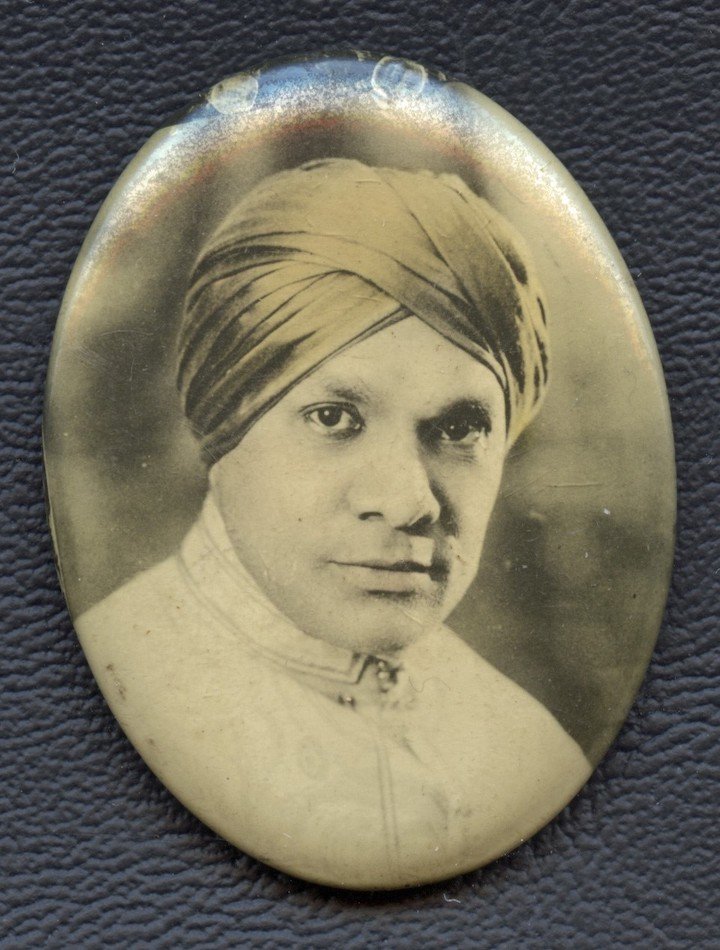Pinback Button of Swami Bhagwan Bissessar
by Philip Deslippe
Pinback button (front) of Swami Bhagwan Bissessar, originally purchased in Detroit in either 1930 or 1932 by one of his students. Collection of the author.
Pinback button (back) of Swami Bhagwan Bissessar, originally purchased in Detroit in either 1930 or 1932 by one of his students. Collection of the author.
The man on the pinback button is Swami Bhagwan Bissessar. For three decades, he traveled across the United States and worked as a yoga teacher and metaphysical lecturer: first from 1927 until 1934 when he married a woman named Vivian Tuttle, and then from 1938 until 1957 when he revived his career under the new moniker “Mahasiddha Satchitananda.” The button was acquired by a student of his in Detroit, most likely when Bissessar passed through the city in the early 1930s and taught at the Hotel Tuller.
In an undergraduate class on religion in America, examining this button could easily lead into some of the well-worn discussions about modern yoga and Asian religions in the United States: the Orientalism that fascinated and horrified different segments of the American population, the “guru” as an essential part of yoga and Hinduism, or the importation of spiritual teachers from South Asia to the United States, often imagined as a simple and unidirectional movement from East to West.
But the button and the life of Bissessar tell a more complicated history of how yoga and Hinduism became a part of the American religious landscape.
A unanimous Supreme Court decision in 1923 rendered immigrants from Asia ineligible for US citizenship. This ineligibility created legal barriers for them on top of already existent informal prejudice. Additionally, dozens of South Asian immigrants who had already become US citizens were denaturalized and found themselves without any citizenship whatsoever.
Out of necessity, dozens of South Asian immigrants in the United States who had hoped to become school teachers or engineers remade themselves into yogis and swamis. They appealed to the American public’s curiosity (and naiveté) about an imagined India and traveled across the country giving free public lectures that fed into smaller private classes of instruction in one city after another.
The history of what was understood as yoga in the United States before the 1960s was largely made up of dozens of these unaffiliated and peripatetic spiritual teachers, but that history is usually narrated through a handful of select figures such as Yogananda and Vivekananda, the famed speaker at the 1893 Parliament of the World’s Religions. These select few tell a story of individual charisma and an inevitable transmission of yoga that makes sense in a world where yoga is now a global billion-dollar industry.
Bissessar’s story is more difficult to weave into a hagiography. He made spurious claims of being an alumnus of Eton and Oxford, gave himself the spurious title of “Master Philosopher of India,” and was once arrested for telling fortunes. Advertisements for his lectures were just as likely to be published in the newspaper under the heading of “Amusements” alongside movies and vaudeville shows as they were to be listed among notices of religious services.
One reporter in 1930 noted how Bissessar offered his audience such a vast array of spiritual and worldly benefits from his teachings of “Yogessar” that an observer was left “wondering how the swami reconcile[d] the Way to Nirvana with the way to easy wealth.”
Bissessar’s status as a guru came simply from repeatedly telling others that he was one. The button is a small (and slightly rusty) bit of evidence that he was the creator of his own myth. Bissessar was not alone in making up claims and titles for himself. His peers would use an ever-shifting array of titles and places of origin as they would travel across the country to varying degrees of success: Rishi from Benares, Yogi from the Himalayas, Master from Tibet.
The personae of traveling yoga teachers during this time were built on more than just advertising copy. Deva Ram Sukul spent large amounts of money on jewelry for himself, lavishly furnished his Chicago-based office in an exotic Orientalist style, and tried on numerous styles of clothing including turbans and tuxedos, all to perfect the effect he would have on his audiences. Yogi Wassan sold vinyl records of himself intoning a healing chant and sold colorful robes so his students could remain connected to him at a distance as their “Super-Akasha” guru. Most yoga teachers sold large glossy photos of themselves so their followers could place them on their home altars (and in their hearts).
It is a well-worn truism that history tends to be told from the perspective of the victors, but the telling of history is also dependent on the records that have been left behind. The select figures who are used to employ the history of modern yoga left behind institutions that continued to uphold their memories, and, as books were the most commonly preserved objects of their creation, the literate and the organized tended to become the most well-remembered.
The dozens of traveling yogis and swamis in the United States during the Interwar period often left behind no institutions, just their students (who usually did not know each other) scattered from one city to another. They produced pamphlets and ephemera which were rarely preserved, and the other artifacts of their decades of teaching—the robes sold by Yogi Wassan, the rings and necklaces of Deva Ram Sukul, and the pinback button of Swami Bhagwan Bissessar—are even more scarce.
The pinback button of Swami Bhagwan Bissessar memorializes a period in the early history of modern yoga that goes against our assumptions: where claims to divinity were created as a fallback plan, where a lecture on yoga was an alternative to a night at the movies, and where a man could advertise himself as a guru just like others would promote a political candidate or a brand of cereal.
Philip Deslippe is a PhD candidate in the Department of Religious Studies at the University of California, Santa Barbara, where he focuses on Asian, metaphysical, and marginal religions in modern America. He has published articles in various journals, including Japanese Religions, Journal of Yoga Studies, and Amerasia.


